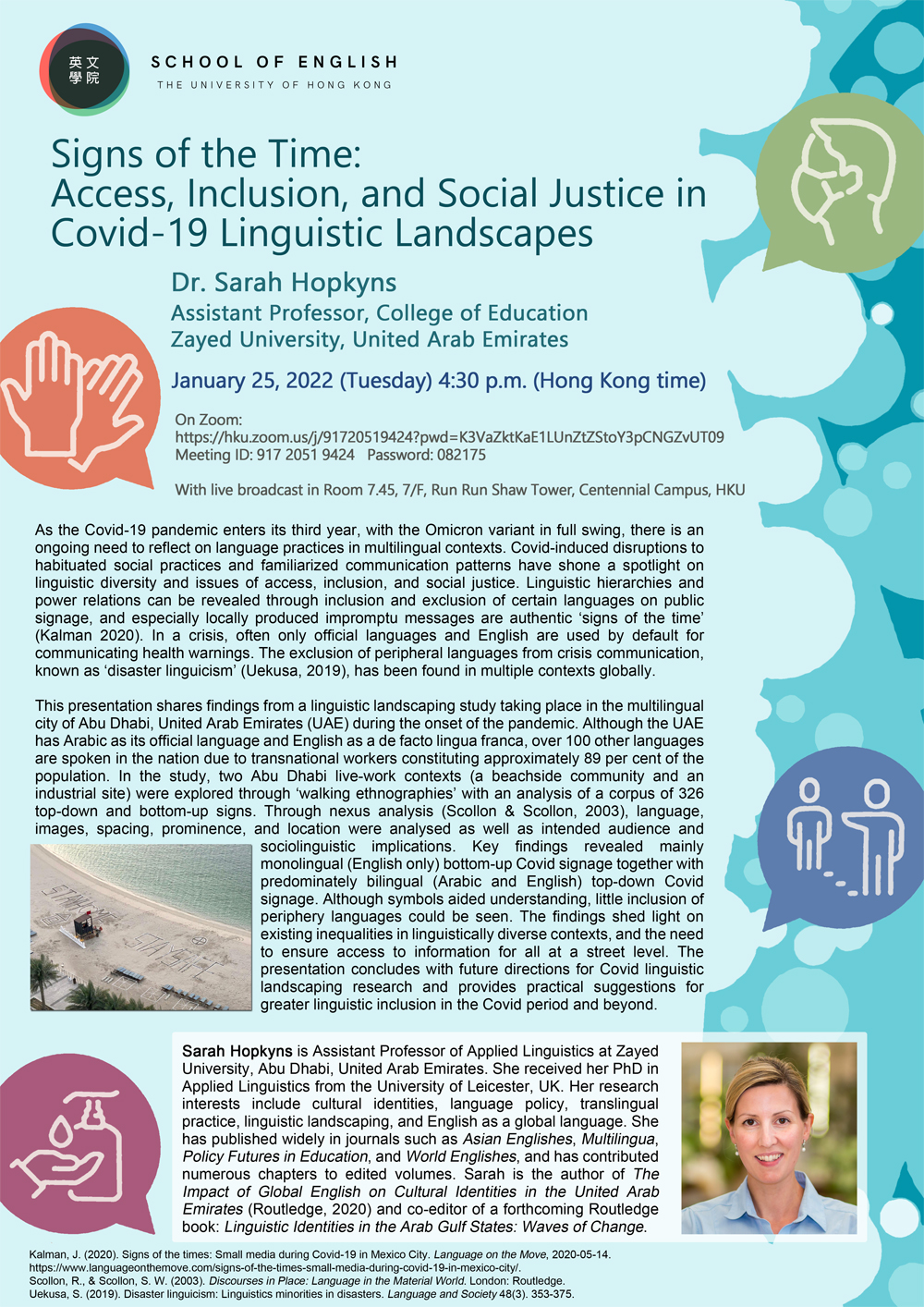Assistant Professor, College of Education, Zayed University, United Arab Emirates
January 25, 2022 (Tuesday), 4:30 p.m. (Hong Kong time)
On Zoom: https://hku.zoom.us/j/91720519424?pwd=K3VaZktKaE1LUnZtZStoY3pCNGZvUT09
Meeting ID: 917 2051 9424
Password: 082175
With live broadcast in Room 7.45, Run Run Shaw Tower, Centennial Campus, HKU
As the Covid-19 pandemic enters its third year, with the Omicron variant in full swing, there is an ongoing need to reflect on language practices in multilingual contexts. Covid-induced disruptions to habituated social practices and familiarized communication patterns have shone a spotlight on linguistic diversity and issues of access, inclusion, and social justice. Linguistic hierarchies and power relations can be revealed through inclusion and exclusion of certain languages on public signage, and especially locally produced impromptu messages are authentic ‘signs of the time’ (Kalman 2020). In a crisis, often only official languages and English are used by default for communicating health warnings. The exclusion of peripheral languages from crisis communication, known as ‘disaster linguicism’ (Uekusa, 2019), has been found in multiple contexts globally.
This presentation shares findings from a linguistic landscaping study taking place in the multilingual city of Abu Dhabi, United Arab Emirates (UAE) during the onset of the pandemic. Although the UAE has Arabic as its official language and English as a de facto lingua franca, over 100 other languages are spoken in the nation due to transnational workers constituting approximately 89 per cent of the population. In the study, two Abu Dhabi live-work contexts (a beachside community and an industrial site) were explored through ‘walking ethnographies’ with an analysis of a corpus of 326 top-down and bottom-up signs. Through nexus analysis (Scollon & Scollon, 2003), language, images, spacing, prominence, and location were analysed as well as intended audience and sociolinguistic implications. Key findings revealed mainly monolingual (English only) bottom-up Covid signage together with predominately bilingual (Arabic and English) top-down Covid signage. Although symbols aided understanding, little inclusion of periphery languages could be seen. The findings shed light on existing inequalities in linguistically diverse contexts, and the need to ensure access to information for all at a street level. The presentation concludes with future directions for Covid linguistic landscaping research and provides practical suggestions for greater linguistic inclusion in the Covid period and beyond.
Sarah Hopkyns is Assistant Professor of Applied Linguistics at Zayed University, Abu Dhabi, United Arab Emirates. She received her PhD in Applied Linguistics from the University of Leicester, UK. Her research interests include cultural identities, language policy, translingual practice, linguistic landscaping, and English as a global language. She has published widely in journals such as Asian Englishes, Multilingua, Policy Futures in Education, and World Englishes, and has contributed numerous chapters to edited volumes. Sarah is the author of The Impact of Global English on Cultural Identities in the United Arab Emirates (Routledge, 2020) and co-editor of a forthcoming Routledge book: Linguistic Identities in the Arab Gulf States: Waves of Change.
Kalman, J. (2020). Signs of the times: Small media during Covid-19 in Mexico City. Language on the Move, 2020-05-14. https://www.languageonthemove.com/signs-of-the-times-small-media-during-covid-19-in-mexico-city/.
Scollon, R., & Scollon, S. W. (2003). Discourses in Place: Language in the Material World. London: Routledge.
Uekusa, S. (2019). Disaster linguicism: Linguistics minorities in disasters. Language and Society 48(3). 353-375.


